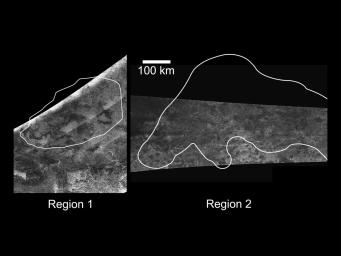
|
Active Cryovolcanic Features on Titan?
- Click the image above for a larger view
- Full-Res JPEG (3000 x 2250) (437.8 kB)
- Full-Res TIFF (3000 x 2250) (6.8 MB)
Caption:
The Cassini Radar Mapper imaged Titan on Feb. 22, 2008 (as shown on the left) and April 30, 2006 (as shown on the right).
These radar images show the outlines of regions "1" and "2" identified by Cassini's visual and infrared mapping spectrometer and inferred to be variable (see VIMS flat map, PIA11701 ), and which have been hypothesized to be due to cryovolcanic activity. The lobate, flow-like features in region 1 are consistent with this interpretation.
Region 1 is just north of the feature named Hotei Arcus and is centered on 28 degrees south latitude by 78 degrees west longitude. The region is about 400 kilometers (249 miles) across. Region 2 is on the western part of Xanadu and is centered on 7 degrees south latitude by 135 degrees west longitude. This region is about 900 kilometers (560 miles) across. In both cases, north is up, and features as small as 300-500 meters can be resolved.
Background Info:
The Cassini-Huygens mission is a cooperative project of NASA, the European Space Agency and the Italian Space Agency. NASA's Jet Propulsion Laboratory, a division of the California Institute of Technology in Pasadena, manages the mission for NASA's Science Mission Directorate, Washington, D.C. The Cassini orbiter was designed, developed and assembled at JPL. The radar instrument was built by JPL and the Italian Space Agency, working with team members from the United States and several European countries.
For more information about the Cassini-Huygens mission visit http://saturn.jpl.nasa.gov/home/index.cfm .
Cataloging Keywords:
| Name | Value | Additional Values |
|---|---|---|
| Target | Titan | |
| System | Saturn | |
| Target Type | Satellite | |
| Mission | Cassini-Huygens | |
| Instrument Host | Cassini Orbiter | |
| Host Type | Orbiter | |
| Instrument | Radar Mapper | Visual and Infrared Mapping Spectrometer (VIMS) |
| Detector | ||
| Extra Keywords | Grayscale, Infrared, Map, Radar, Visual, Volcano | |
| Acquisition Date | ||
| Release Date | 2008-12-15 | |
| Date in Caption | 2006-04-30 | 2008-02-22 |
| Image Credit | NASA/JPL-Caltech/ASI | |
| Source | photojournal.jpl.nasa.gov/catalog/PIA11702 | |
| Identifier | PIA11702 | |
